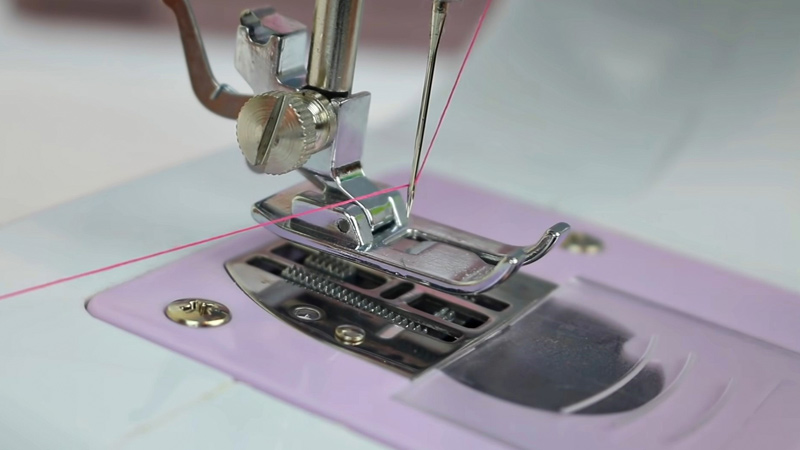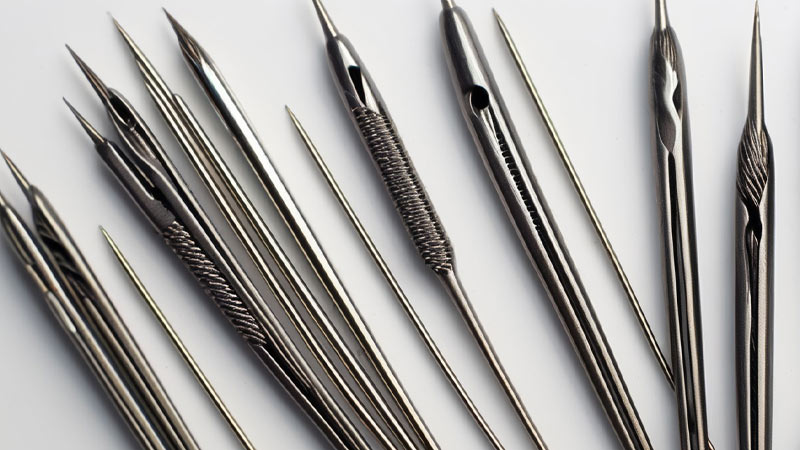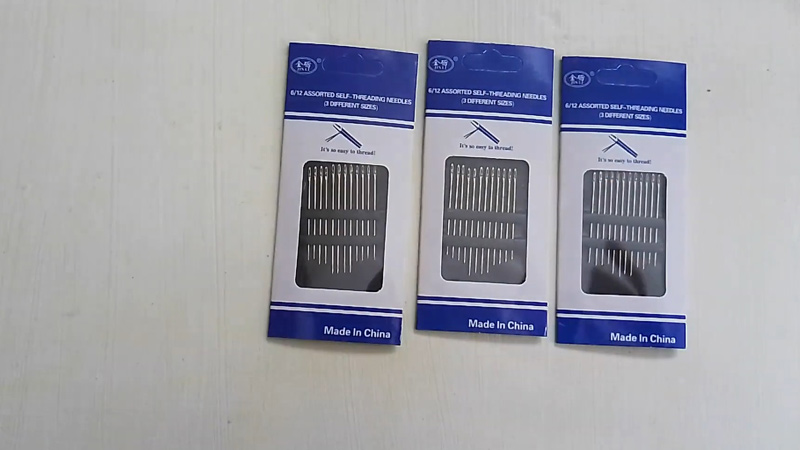Household sewing needles, essential tools for crafting and mending, exhibit diverse materials and constructions.
The metal composition of these needles plays a pivotal role in determining their strength, durability, and suitability for various sewing tasks.
Carbon steel, renowned for its robustness, finds common usage in hand-sewing needles, maintaining a sharp edge over time.
Stainless steel, prized for its corrosion resistance, is prevalent in hand-sewing and machine needles. Nickel-plated and titanium-coated needles offer additional protective layers, enhancing longevity and wear resistance.
Aluminum and gold-plated needles, although less common, cater to specialized needs. Understanding the metal choices illuminates the nuanced considerations behind creating these indispensable tools.

6 Types of Metals Are Household Sewing Needles Made From
Household sewing needles are typically made from various types of metals, each chosen for its specific properties and suitability for the task at hand.
The choice of metal depends on factors such as durability, flexibility, and corrosion resistance.
Here are the common types of metals used in the production of household sewing needles:
1. Carbon Steel

Carbon steel needles are prized for their robustness and durability. Composed primarily of iron with a small percentage of carbon, these needles are well-suited for hand-sewing tasks.
The carbon content contributes to their strength, allowing them to withstand the repeated pressure and friction of sewing.
Furthermore, carbon steel needles maintain a sharp point over an extended period, ensuring precise and efficient stitching.
Their reliability makes them a staple for various sewing projects, from basic mending to intricate needlework.
2. Stainless Steel

Stainless steel needles are renowned for their corrosion-resistant properties, making them a staple in hand-sewing and machine needle manufacturing.
Comprising iron, chromium, nickel, and other alloys, stainless steel needles exhibit excellent resistance to rust, a crucial feature when needles may come into contact with moisture during sewing.
The longevity and durability of stainless steel needles make them a popular choice for sewers who seek reliability and performance in a wide range of applications.
3. Nickel-Plated Steel
Nickel-plated needles offer a layer of protection and enhanced performance. With a coating of nickel on the surface of the steel, these needles gain additional resistance to corrosion.
The smooth surface the nickel plating creates reduces friction during sewing, promoting smoother and more precise stitching.
Beyond functionality, the shiny appearance imparted by the nickel plating adds an aesthetic touch, making these needles a preferred choice for those who appreciate both performance and visual appeal in their sewing tools.
4. Titanium-Coated Steel
Titanium-coated needles represent a premium option, prized for their exceptional durability. The thin layer of titanium coating on the steel enhances the needle’s resistance to wear, extending its lifespan significantly.
This makes titanium-coated needles ideal for high-performance sewing applications where longevity and consistent performance are crucial.
The use of titanium reinforces the needle’s structural integrity and contributes to its smooth operation, ensuring a reliable and precise sewing experience.
5. Aluminum
While less common, aluminum needles find their niche in specialty applications and fabrics. The lightweight nature of aluminum needles makes them suitable for delicate fabrics, where a lighter touch is desired.
Although not as prevalent as other materials, aluminum needles provide an alternative for specific sewing needs, offering a balance between strength and weight that suits specific projects and preferences.
6. Gold-Plated
Gold-plated needles offer a unique option for those seeking a touch of luxury in their sewing experience.
Using gold, a noble metal, not only adds an element of opulence but also provides corrosion resistance.
The gold plating contributes to a smoother surface, reducing friction during sewing and enhancing the overall stitching experience.
Gold-plated needles are often favored by enthusiasts who appreciate their sewing tools’ combination of performance and elegance.
How to Choose the Right Sewing Needle for a Specific Fabric?
Choosing the right sewing needle for a specific fabric is crucial for optimal stitching results.
The type and weight of the fabric, as well as the needle’s size and construction, play significant roles in determining the success of your sewing project.
Here’s a guide on how to select the appropriate sewing needle for different fabrics:
Consider Fabric Type
When considering the fabric type, it’s essential to consider the unique characteristics of the material you’re working with.
A universal or sharp needle works well for natural fibers like cotton, ensuring precise and clean stitches on lightweight to medium-weight fabrics.
If you’re dealing with denim, a sturdier denim or jeans needle is crucial to pierce through the thickness and durability of the material.
Delicate fabrics such as silk and satin require a gentle touch, making fine or silk needles the ideal choice to prevent any potential snags or damage during stitching.
Match Needle Size to Fabric Weight
Matching the needle size to the fabric weight ensures that your sewing machine can smoothly penetrate the material without causing any distortion or damage.
Choosing a smaller needle size, like 60/8 or 70/10, is suitable for lightweight fabrics such as chiffon—medium-weight fabrics like cotton or linen benefit from a mid-range needle, typically an 80/12.
For heavyweight fabrics like denim or canvas, opting for larger needles in the range of 90/14 or 100/16 is necessary to handle the increased thickness.
Needle Shape and Point
The shape and point of the needle play a crucial role in determining how well it interacts with different fabrics.
Universal needles, featuring a slightly rounded point, are versatile and can be used with various fabrics.
With their rounded tip, ballpoint needles are designed for knit and stretch fabrics, preventing snags and ensuring smooth stitching.
Sharps or quilting needles, with their slender design and fine points, are perfect for achieving precision on lightweight fabrics, making them a go-to choice for quilting enthusiasts.
Consider Needle Construction
Needle construction, including coatings and unique features, can significantly impact performance.
Coated needles, such as those with titanium or chrome coatings, offer enhanced durability and reduced friction during stitching, contributing to a smoother sewing experience.
Double needles, equipped with two parallel needles on a single shaft, are excellent for creating decorative stitches or hemming, adding versatility to your sewing toolkit.
Specialty Needles
Specialty needles cater to specific project requirements. Embroidery needles, with their larger eye, accommodate thicker embroidery threads used in machine embroidery projects.
Quilting needles, featuring a tapered point, are specifically designed for piercing through multiple layers of fabric in quilting, ensuring precise and even stitches.
Check Machine Compatibility
Ensuring the compatibility of the chosen needle with your sewing machine is crucial for smooth operation.
Some machines may have specific needle requirements, and using the wrong needle can lead to stitching issues or even damage the machine.
Refer to your sewing machine’s manual or guidelines to determine the recommended needle types.
Test Stitch on Scrap Fabric
Before starting your main project, conducting a test stitch on a scrap piece of fabric is a practical step. This allows you to evaluate the chosen needle’s performance, stitch quality, and tension.
It’s an opportunity to make necessary adjustments before committing to your final piece, ensuring a successful and frustration-free sewing experience.
Replace Needles Regularly
Needles are subject to wear and tear, especially when dealing with dense or tough fabrics. Regularly replacing needles is essential to maintain consistent stitch quality and prevent issues like skipped stitches or fabric damage.
A well-maintained needle ensures that your sewing projects proceed smoothly and produce professional-looking results.
What Are Sewing Needles Used For?
Sewing needles are essential tools in the world of textile and garment construction, serving various purposes in both hand-sewing and machine sewing.
These slender, pointed instruments are designed to penetrate fabrics, creating stitches that bind materials together. Here are the primary uses of sewing needles:
Basic Stitching
- Hand-Sewing: Hand-sewing needles are fundamental tools for creating basic stitches. They are used to sew seams, attach buttons, mend fabric tears, and perform other manual stitching tasks.
- Machine Sewing: Machine needles, whether universal, ballpoint, or specialty needles, play a vital role in creating basic stitches when operating a sewing machine. They are compatible with various fabrics, ensuring the proper formation of stitches in a timely and efficient manner.
Embroidery
- Hand Embroidery Needles: These needles have a giant eye to accommodate embroidery threads and are designed for intricate hand embroidery work. They allow for detailed stitching and the creation of decorative designs on fabrics.
- Machine Embroidery Needles: Specialized needles designed for use with embroidery machines. They have features such as a giant eye and a specially designed scarf to facilitate the use of embroidery threads.
Quilting
These needles are designed for stitching through multiple layers of fabric, batting, and backing material when quilting. They are available in various lengths and thicknesses to suit different quilting techniques.
Serger/Overlock Machines
These needles are specifically designed for use in serger or overlock machines. They create overlock stitches that finish fabric edges neatly and prevent fraying.
Specialty Stitches and Techniques
There are needles designed for specific techniques and fabrics. For example, ballpoint needles are ideal for knit fabrics, while leather needles are crafted for working with leather and other heavy materials.
Topstitching needles are designed for creating prominent and decorative stitches on the surface of fabrics.
Topstitching and Decorative Work
They are used for creating visible and decorative stitches on the surface of fabrics. These needles often have more prominent eyes to accommodate thicker topstitching threads.
Buttonholes
Specialized needles designed for sewing buttonholes. They are often combined with the buttonhole function on sewing machines to create precise and durable buttonholes.
Twin and Triple Needle Sewing
These needles have two needles mounted on a single shaft and are used for creating parallel rows of stitches, such as hems or decorative stitching. Triple needles, with three needles, are also available for specific applications.
FAQs
What Metal Are Sewing Needles Made Of?
Sewing needles are typically made from various metals, including carbon steel, stainless steel, and occasionally aluminum or gold-plated for specialty purposes.
Are Needles Made of Metal?
Yes, most sewing needles are made of metal.
What Are Needles Made Of?
Needles used for sewing are commonly made of metals such as carbon steel or stainless steel.
Specialty needles may also have nickel, titanium, or gold coatings for specific applications.
What Are Sewing Needles Made Out Of?
Sewing needles are made of various metals, with carbon steel and stainless steel being common choices.
Coatings like nickel or titanium may be applied for added durability, and specialty needles may use materials like aluminum or gold for specific purposes.
Who Invented the Sewing Needle?
The sewing needle’s invention is attributed to archaic humans, the Denisovans, with a 50,000-year-old bird bone needle discovered in Denisova Cave and an Aurignacian-age bone needle dating back 47,000 to 41,000 years in Potok Cave, Slovenia.
To Recap
The selection of metal for household sewing needles reflects a nuanced balance between strength, durability, and specialized requirements.
From the robustness of carbon steel to the corrosion resistance of stainless steel and the protective layers of nickel plating and titanium coating, each metal uniquely enhances the longevity and performance of these essential tools.
The inclusion of specialty options like aluminum and gold-plated needles adds a touch of versatility and luxury to the sewing experience.
As we appreciate the intricacies of needle construction, we gain a deeper understanding of the craftsmanship behind these indispensable instruments, ensuring that our sewing endeavors are functional and tailored to the crafting world’s diverse needs.
Leave a Reply